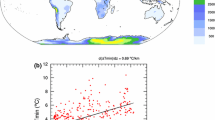Summary
For the estimation of a potential climatic change induced by a doubling of atmospheric CO2 we use the results of three-dimensional general circulation models (GCM). Although the results from present climate modeling cannot be considered as predictions of future climatic conditions due to the inherent models' deficiencies, they can still serve a useful purpose in climate change scenarios. The reason for this is that climate models are the only tools available to study the response of the climate system to a perturbation in a physically consistent manner and that such types of models can provide a consistent data set of high temporal and spatial resolution. For the Mediterranean area, the results obtained from three different GCMs, namely, the British Meteorological Office model (BMO), the Goddard Institute for Space Studies model (GISS), and the National Center for Atmospheric Research model (NCAR) are shown. The regional and seasonal distributions of temperature, precipitation, and soil moisture are used to study the potential changes. The results indicate that the CO2-induced changes for temperature generated by the three models are of similar magnitude. The values of the area mean change range between 2.5 and 4.0 K. The precipitation response results in a diverse pattern. The physical mechanism likely to be responsible for the simulated climatic changes are identified and their statistical significance is tested. This type of work will help us develop the methodology and assist us in gaining insight into the use of climate model scenarios for impact analysis.
Zusammenfassung
Zur Abschätzung einer möglichen Klimaänderung als Folge einer Verdopplung der CO2-Konzentration in der Atmosphäre dienen die Ergebnisse von Studien mit drei-dimensionalen Modellen der atmosphärischen Zirkulation. Diese Ergebnisse können nicht als Klimavorhersagen betrachtet werden, da die gegenwärtigen Modelle noch erhebliche Mängel aufweisen. Sie bilden jedoch die Grundlage zur Entwicklung von Klimaszenarien. Klimamodelle sind gegenwärtig die einzigen Hilfsmittel, um die Reaktion des Klimasystems auf eine externe Störung in physikalisch konsistenter Weise und in hoher zeitlicher und räumlicher Auflösung zu simulieren. Für den Mittelmeerraum werden die Ergebnisse dreier verschiedener Klimamodelle (British Meteorological Office (BMO); Goddard Institute for Space Studies (GISS); National Center for Atmospheric Research (NCAR)) anhand der regionalen und saisonalen Verteilungen von Temperatur, Niederschlag und Bodenfeuchte vorgestellt. Die durch einen CO2-Anstieg verursachte Änderung der Temperaturverteilung ist bei den drei Modellergebnissen ähnlich. Die räumlichen Mittelwerte liegen zwischen 2,5 und 4,0 K. Der Vergleich der Verteilung hydrologischer Größen ergibt dagegen kein einheitliches Bild. Die den simulierten Klimaänderungen zugrunde liegenden physikalischen Mechanismen werden benannt und die statistische Signifikanz der Klimaänderung wird getestet. Diese Arbeit dient zur Entwicklung einer Methodologie für den Einsatz von Klimamodellszenarien bei der Impaktanalyse.
Similar content being viewed by others
References
Bach, W.: Our Threatened Climate: Ways of Averting the CO2-Problem Through Rational Energy Use. Dordrecht: Reidel Publ. Co. 1984.
Bach, W., Jung, H. J., Knottenberg, H.: Developments of Regional Climate Scenarios. In: Socioeconomic Impacts of Climatic Changes. Report for the EEC and BMFT. Friedrichshafen: Dornier System 1984.
Chervin, R. M.: On the Comparison of Observed and GCM Simulated Climate Ensembles. J. Atmos. Sci.38, 885–901 (1981).
Dennett, M. O., Elston, J., Diegoq, R.: Weather and Yields of Tobacco, Sugar Beet and Wheat in Europe. Agric. Met.21, 249–263 (1980).
Gates, W. L.: The Use of General Circulation Models in the Analysis of the Ecosystem Impacts of a Climatic Change. Paper presented at the Study Conference on the sensitivity of ecosystem and society to climatic change, Villach, 19–23 September, 1983.
Gates, W. L., Bach, W.: Analysis of a Model Simulated Climate Change as a Scenario for Impact Studies. Report for the German Federal Environmental Agency, R&D No. 104-02-513, 163 pp. (1981).
Hansen, J., Russell, G., Rind, D., Stone, P., Lacis, A., Lebedeff, S., Ruedy, R., Travis, L.: Efficient Three-Dimensional Global Models for Climate Studies: Models I and II. Mon. Weath. Rev.110, 609–662 (1983).
Hansen, J., Lacis, A., Rind, D., Russell, G., Stone, P., Fung, J., Ruedy, R., Lerner, J.: Climate Sensitivity: Analysis of Feedback Mechanisms. In: Climate Processes and Climate Sensitivity (Hansen, J., Takahashi, T., eds.). Geophys. Monogr. 29, Maurice Ewing5, 130–163 (1984).
Katz, R. W.: Statistical Evaluation of Climate Experiments with General Circulation Models: A Parametric Time Series Modeling Approach. J. Atmos. Sci.39, 1446–1455 (1982).
Lough, J. M., Wigley, T. M. L., Palutikof, J. P.: Climate and Climate Impact Scenarios for Europe in a Warmer World. J. Climat. and Appl. Met.22, 1673–1684 (1983).
Manabe, S.: Climate and the Ocean Circulation, 1: The Atmospheric Circulation and the Hydrology of the Earth's Surface. Mon. Weath. Rev.97, 739–774 (1969).
Manabe, S., Wetherald, R. T., Stouffer, R. J.: Summer Dryness due to an Increase of Atmospheric CO2 Concentration. Climatic Change3, 347–386 (1981).
Mitchell, J. F. B.: The Seasonal Response of a General Circulation Model to Changes in CO2 and Sea Surface Temperature. Quart. J. R. Met. Soc.109, 113–152 (1983).
Mitchell, J. F. B.: The Hydrological Cycle as Simulated by an Atmospheric General Circulation Model. In: Variations in the Global Water Budget (Street-Perrott, A., et al., eds.), pp. 429–446. Dordrecht: Reidel Publ. Co. 1983.
Rind, D.: The Influence of Ground Moisture Conditions in North America on Summer Climate as Modeled in the GISS GCM. Mon. Weath. Rev.110, 1487–1494 (1982).
Rowntree, P. R., Bolton, J. A.: Effects of Soil Moisture Anomalies over Europe in Summer. In: Variations in the Global Water Budget (Street-Perrott, A., et al., eds.), pp. 447–462. Dordrecht: Reidel Publ. Co. 1983.
Schlesinger, M. E.: Simulating CO2-Induced Climatic Change with Mathematical Climate Models: Capabilities, Limitations and Prospects, III3-III139, US DOE 021, Washington, D.C. 1983.
US NRC: Changing Climate. Washington, D.C.: National Academy Press 1983.
Washington, W. M., Meehl, G. A.: Seasonal Cycle Experiments on the Climate Sensitivity due to a Doubling of CO2 with an Atmospheric General Circulation Model Coupled to a Simple Mixed Layer Ocean Model. J. Geophys. Res.89, 9475–9503 (1984).
Author information
Authors and Affiliations
Rights and permissions
About this article
Cite this article
Jung, H.J., Bach, W. GCM-derived climatic change scenarios due to a CO2-doubling applied for the Mediterranean area. Arch. Met. Geoph. Biocl., Ser. B 35, 323–339 (1985). https://doi.org/10.1007/BF02334488
Received:
Issue Date:
DOI: https://doi.org/10.1007/BF02334488




